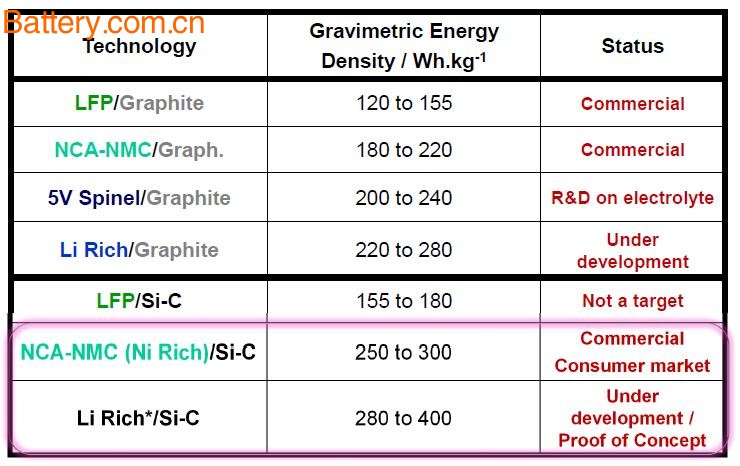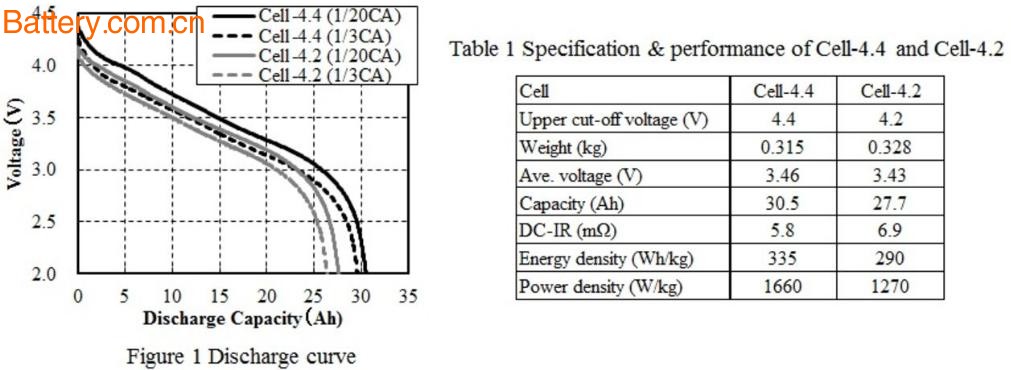On March 1, the four ministries and commissions issued a notice on the “Action Plan for Promoting the Development of Automotive Power Battery Industryâ€, clearly pointing out the shortcomings of the current power battery and the future development direction. The notice will improve battery specific energy as one of the key development goals in the future. The key indicators and time nodes are as follows: 1. By 2020, the specific energy of lithium-ion power battery cells is >300Wh/kg; the system specific energy is 260Wh/kg; the cost is <1 yuan/watt hour; the use environment is -30°C to 55°C; and the 3C charging capacity is available. 2. By 2025, the monomer specific energy reaches 500Wh/kg. 3. Strive to realize the industrialization and complete vehicle application of lithium ion battery products with single cell 350Wh/kg and system 260Wh/kg. 4. In terms of new power batteries, we will actively promote the research and engineering development of lithium-sulfur batteries, metal-air batteries, and solid-state batteries. In 2020, the specific energy of the monomer will be >400Wh/kg, and in 2025, it will reach 500Wh/k. From the text description of the indicator, we can see that the first indicator is required to be realized under the lithium-ion battery system, and the third indicator should be rushed forward under the lithium-ion battery system, so it is proposed to "achieve ". As for the second and fourth indicators, the lithium-ion battery system is estimated to be powerless, and a new battery system must be developed. Although the research history of lithium-sulfur batteries, metal-air batteries, and solid-state batteries has been long, the technological progress is still relatively slow. Nowadays, various cross-disciplinary developments have made great progress, which will help to continue to develop these battery systems, and look forward to a breakthrough. It is often seen that many media reports confuse "specific energy" and "energy density." Generally, "specific energy" is used to describe the energy level per unit mass (Wh/kg), and "energy density" is used to describe the energy level per unit volume (Wh/L). Here we mainly look at the specific energy development path under the lithium-ion battery system.  Lithium-ion battery cell specific energy The Energy Technology and New Energy Vehicle Technology Roadmap released in 2016 mentioned that the specific energy target of pure electric vehicle power battery is 350Wh/kg in 2020, 400Wh/kg in 2025, and 500Wh/kg in 2030. This goal is very close to the indicators proposed by the four ministries, and it has also sparked heated discussions in the industry. Let's take a look at the specific energy goals and implementation paths of the major battery companies reported in the 2016 media: · BYD: The ternary battery hopes to achieve 240Wh/kg in 2018 and 300Wh/kg in 2020. The positive electrode is made of high-nickel ternary material, and the negative electrode is made of silicon oxide or nano-silicon. · Ningde era: 200-250Wh/kg can be achieved in 2016, and the 350Wh/kg target is expected during the 13th Five-Year Plan. The material system is high nickel ternary/silicon carbon material. · Guoxuan Hi-Tech: The target for 2020 is 300-350Wh/kg, using high-nickel ternary cathode material, silicon-based anode material, 5V high-voltage electrolyte · BAK: The 18650 cylinder fourth generation (3.0Ah) can generally reach 220-230Wh/kg, and the specific energy of the fifth generation product (3.6Ah) in 2017 is expected to reach 250Wh/kg. Bick is the company that locked the ternary material route earlier. · Lishen: It is developing 200-250Wh/kg products, cylindrical batteries can reach 250Wh/kg, and strive to reach 300Wh/kg in 2020, using the third generation of lithium-rich manganese-based layered materials and silicon anode materials. · Samsung SDI: 2016 level is 250Wh/kg, and is expected to reach 350Wh/kg in 2030 (possibly using other battery systems) It is worth noting that the three battery companies in Ningde era, Tianjin Lishen and Guoxuan Hi-Tech were also selected as key projects of the Ministry of Science and Technology in 2016. The evaluation indicators of the project are: · Power battery new material new system (basic frontier category): assessment index: new lithium-ion battery sample energy density ≥400Wh/kg, new system battery sample energy density ≥500Wh/kg · High specific energy lithium-ion battery technology (major common key technology): evaluation index: battery cell energy density ≥300Wh/kg, cycle life ≥1500 times, cost ≤0.8 yuan/Wh, safety and other requirements meet national standards; The production capacity is ≥200 GWh, and the cumulative sales of products are ≥3000 MWh or the number of loading ≥1000 sets. These key special assessment indicators also put forward requirements for cycle life, safety performance, and even sales volume and capacity. This is not a small test for the short-listed battery companies. As can be seen from all the public information, the technical routes for China's major battery companies to achieve 300Wh/kg can be summarized as: · Cathode material: high nickel ternary, or lithium-rich manganese · Anode material: silicon based material · Electrolyte: high pressure electrolyte · Diaphragm: Currently mainly PP, PE, plus ceramic coating The following table shows a set of data presented at the 2015 European-Japan Technical Symposium, which describes the material systems that can be used to achieve different specific energy levels under a lithium-ion battery system. It can be seen that in fact, in the choice of material system, the situation in each country is relatively similar. Let's take a look at the situation of Japanese battery companies. Under the leadership of NEDO (New Energy and Industrial Technology Development Organization of Japan), Japanese battery companies are actively involved in the research and investment of high-energy batteries. For example, let's look at a set of data for 2016 Hitachi Hitachi: · Cathode material: high nickel layered ternary · Positive electrode: 335g/m^2, 3.0g/cm^3 · Anode material: composite of silicon alloy and graphite, capacity ratio 1:1 · Negative electrode: 2.1g/cm^2 · Battery capacity: 30Ah, soft pack battery · Charging upper limit voltage: 4.2 or 4.4V · Lower discharge voltage: 2.0V · Current: C/20, or C/3 Figure 1 is its test data. We can see that when the charging voltage is 4.2V, the current is C/20 (Cell-4.2), the specific energy is 290Wh/kg; when the charging voltage is 4.4V, the current is C/20 (Cell-4.4), the specific energy It is 335Wh/kg. At the same time, Hitachi also pointed out that although the initial specific energy is high, the capacity decays greatly after 100 cycles. Estimating this situation is also a problem that many battery companies are currently experiencing: the energy index is achieved, but other performance is not enough. Figure 1 Hitachi 30Ah battery data On the whole, the goal of achieving 300Wh/kg alone is basically feasible in 2020. The question is: Does the achievement of this goal mean that it can be used in electric vehicles? The answer is definitely no. Automotive power battery is a system engineering, which meets the specific energy requirement is only one of the conditions, other performance (charge and discharge rate, power, life, safety, etc.) is also crucial. On the basis of achieving the goal of high specific energy, it is necessary to invest more time and energy in comprehensive development and improvement of other performance indicators. Van Truck,Cargo Van Truc,Container Van Truck,Mini Van Truck Hubei Jiangnan Special Automobile Co., Ltd , https://www.cn-firetrucks.com

